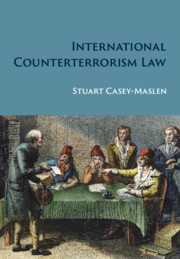188 results

International Counterterrorism Law
- Coming soon
-
- Expected online publication date:
- July 2024
- Print publication:
- 31 July 2024
-
- Book
- Export citation
The EU’s Role in Addressing Human Rights Violations in Hong Kong: Realistic Expectations or Pie in the Sky?
-
-
- Book:
- European Yearbook on Human Rights 2022
- Published by:
- Intersentia
- Published online:
- 20 April 2023
- Print publication:
- 30 November 2022, pp 177-202
-
- Chapter
- Export citation
Contents
-
- Book:
- International Law and Policy on the Protection of Civilians
- Published online:
- 11 August 2022
- Print publication:
- 25 August 2022, pp vii-xiv
-
- Chapter
- Export citation
Introduction
-
- Book:
- International Law and Policy on the Protection of Civilians
- Published online:
- 11 August 2022
- Print publication:
- 25 August 2022, pp 1-16
-
- Chapter
- Export citation
Reviews
-
- Book:
- International Law and Policy on the Protection of Civilians
- Published online:
- 11 August 2022
- Print publication:
- 25 August 2022, pp i-ii
-
- Chapter
- Export citation
17 - The African Union and the Protection of Civilians
- from Part III - State and Institutional Policies on the Protection of Civilians
-
- Book:
- International Law and Policy on the Protection of Civilians
- Published online:
- 11 August 2022
- Print publication:
- 25 August 2022, pp 201-208
-
- Chapter
- Export citation
18 - The European Union and the Protection of Civilians
- from Part III - State and Institutional Policies on the Protection of Civilians
-
- Book:
- International Law and Policy on the Protection of Civilians
- Published online:
- 11 August 2022
- Print publication:
- 25 August 2022, pp 209-218
-
- Chapter
- Export citation
4 - The Protection of Refugees
- from Part I - The International Legal Framework
-
- Book:
- International Law and Policy on the Protection of Civilians
- Published online:
- 11 August 2022
- Print publication:
- 25 August 2022, pp 67-73
-
- Chapter
- Export citation
20 - Switzerland and the Protection of Civilians
- from Part III - State and Institutional Policies on the Protection of Civilians
-
- Book:
- International Law and Policy on the Protection of Civilians
- Published online:
- 11 August 2022
- Print publication:
- 25 August 2022, pp 225-228
-
- Chapter
- Export citation
Part II - Specific Protection of Certain High-Risk Groups
-
- Book:
- International Law and Policy on the Protection of Civilians
- Published online:
- 11 August 2022
- Print publication:
- 25 August 2022, pp 107-164
-
- Chapter
- Export citation
3 - Protection of Civilians under Human Rights Law
- from Part I - The International Legal Framework
-
- Book:
- International Law and Policy on the Protection of Civilians
- Published online:
- 11 August 2022
- Print publication:
- 25 August 2022, pp 50-66
-
- Chapter
- Export citation
1 - Jus ad Bellum and the Protection of Civilians
- from Part I - The International Legal Framework
-
- Book:
- International Law and Policy on the Protection of Civilians
- Published online:
- 11 August 2022
- Print publication:
- 25 August 2022, pp 19-29
-
- Chapter
- Export citation
Foreword
-
- Book:
- International Law and Policy on the Protection of Civilians
- Published online:
- 11 August 2022
- Print publication:
- 25 August 2022, pp xv-xvi
-
- Chapter
- Export citation
12 - Protection of Medical and Humanitarian Personnel
- from Part II - Specific Protection of Certain High-Risk Groups
-
- Book:
- International Law and Policy on the Protection of Civilians
- Published online:
- 11 August 2022
- Print publication:
- 25 August 2022, pp 145-150
-
- Chapter
- Export citation
Conclusion
- from Part III - State and Institutional Policies on the Protection of Civilians
-
- Book:
- International Law and Policy on the Protection of Civilians
- Published online:
- 11 August 2022
- Print publication:
- 25 August 2022, pp 282-283
-
- Chapter
- Export citation
Appendix 1 - Overview of Relevant International Law
-
- Book:
- International Law and Policy on the Protection of Civilians
- Published online:
- 11 August 2022
- Print publication:
- 25 August 2022, pp 284-293
-
- Chapter
- Export citation
24 - India and the Protection of Civilians
- from Part III - State and Institutional Policies on the Protection of Civilians
-
- Book:
- International Law and Policy on the Protection of Civilians
- Published online:
- 11 August 2022
- Print publication:
- 25 August 2022, pp 254-257
-
- Chapter
- Export citation
25 - Norway and the Protection of Civilians
- from Part III - State and Institutional Policies on the Protection of Civilians
-
- Book:
- International Law and Policy on the Protection of Civilians
- Published online:
- 11 August 2022
- Print publication:
- 25 August 2022, pp 258-261
-
- Chapter
- Export citation
Preface
-
- Book:
- International Law and Policy on the Protection of Civilians
- Published online:
- 11 August 2022
- Print publication:
- 25 August 2022, pp xvii-xviii
-
- Chapter
- Export citation
Part III - State and Institutional Policies on the Protection of Civilians
-
- Book:
- International Law and Policy on the Protection of Civilians
- Published online:
- 11 August 2022
- Print publication:
- 25 August 2022, pp 165-283
-
- Chapter
- Export citation



